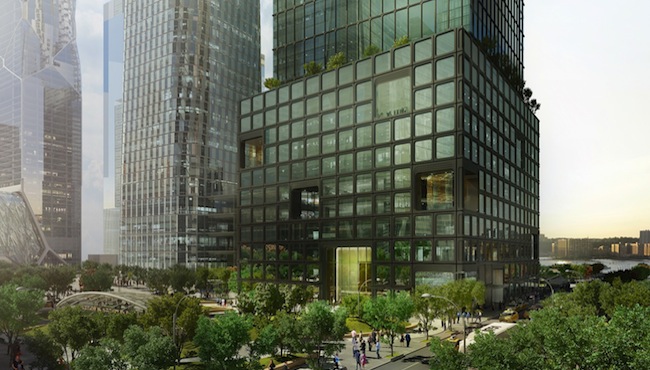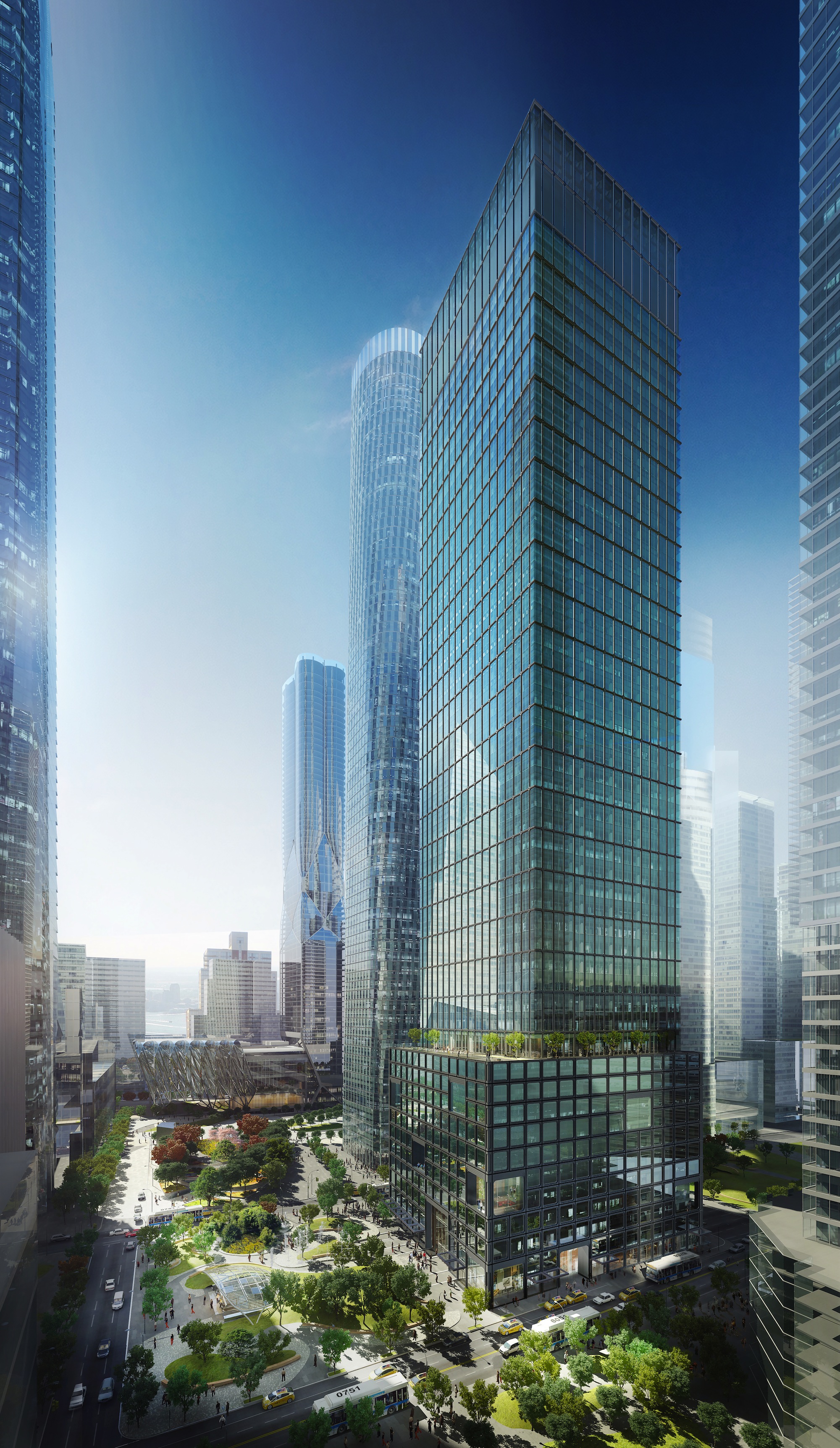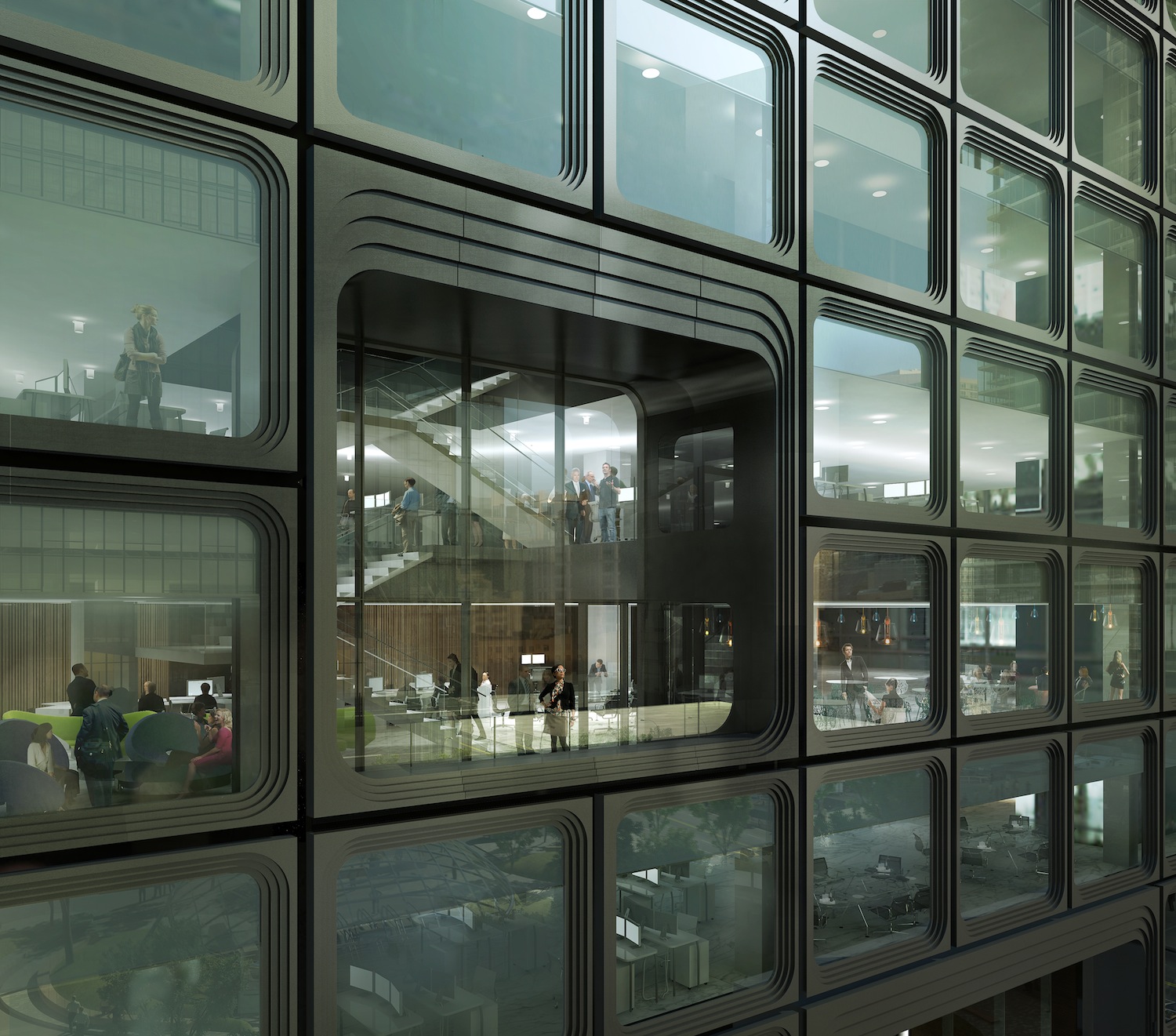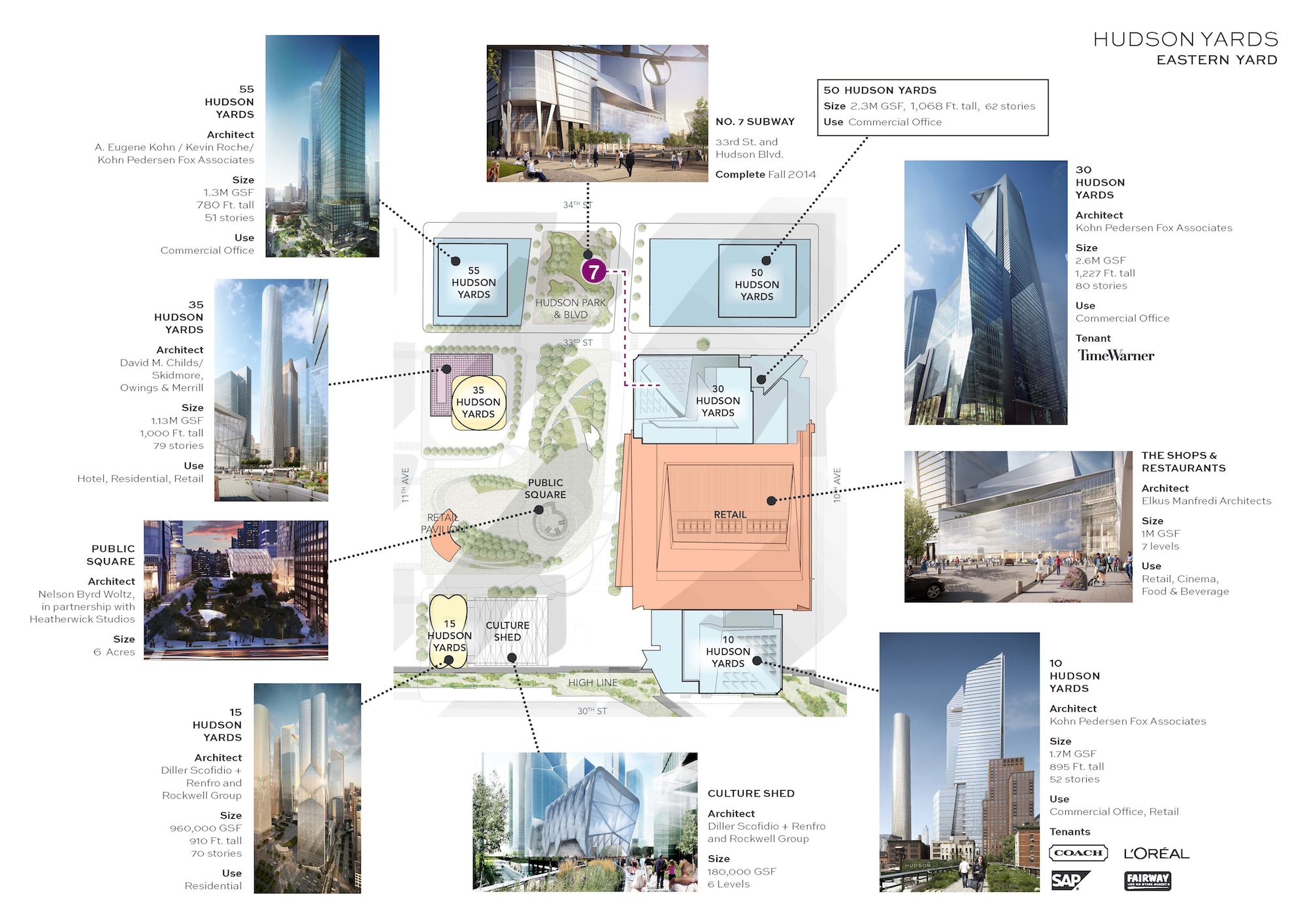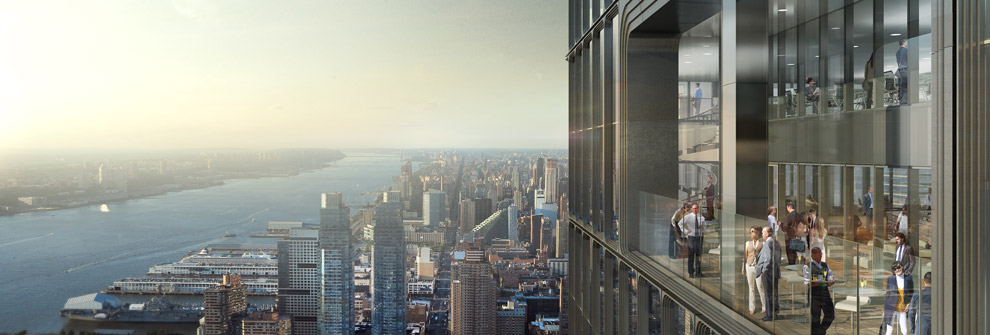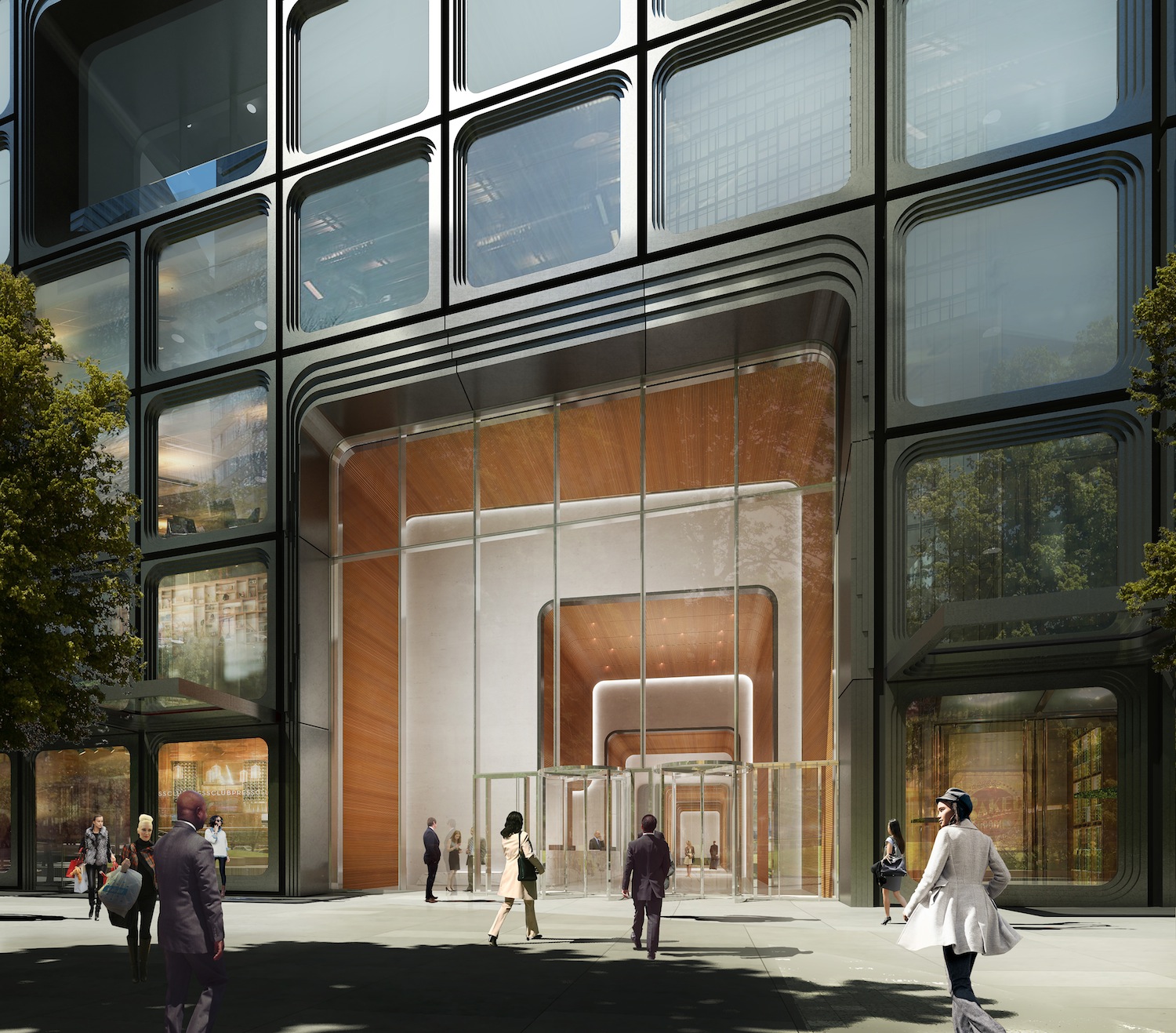Related Companies and Oxford Properties Group today unveiled Fifty Five Hudson Yards, the latest addition to the commercial office tower collection in the 28-acre Hudson Yards development. The building is perfectly positioned at the intersection of Hudson Yards, the High Line and Hudson Park & Boulevard.
The entrance to the building is just across from the new No. 7 subway extension which connects to every other major subway line as well as Grand Central Station. Penn Station is also a less than five-minute walk away. The anticipated LEED Gold, 51-story, 1.3 million gross square foot building is slated to commence construction in January of 2015 and be ready for occupancy at the end of 2017.
The design of Fifty Five Hudson Yards is defined by its indoor-outdoor spaces, SoHo and early modernism inspired exterior design, and exceptionally efficient interior space planning. The conceptual design of the building was a joint venture of A. Eugene Kohn of Kohn Pedersen Fox (KPF) and Pritzker Prize-winning architect Kevin Roche; KPF served as the Design Architect.
One of the few office buildings in the entire city opening directly onto a park, the main lobby of Fifty Five Hudson Yards sits at the southwestern edge of the City’s new Hudson Park. With a unique buffer of green space, light and air around the building, Fifty Five Hudson Yards offers a welcoming arrival experience for building tenants and visitors. The architects built on the appeal of this great outdoor space by designing a dramatic outdoor terrace overlooking the park on the building’s tenth floor.
Situated where the building sets back from the podium floors to the tower, this elegantly landscaped vantage will provide scenic views of Hudson Park as it extends to the north, and the Hudson Yards Public Square and the High Line to the south. The ability to provide gracious indoor-outdoor space continues up the building as the design offers the ability to carve private, double-height terrace spaces into the tower in flexible locations. These tower terraces allow tenants and guests to enjoy an outdoor experience surrounded by superb views of the Hudson River and the Midtown skyline without having to leave the building.
The revitalized High Line district, the manufactured cast iron façade of SoHo commercial buildings and the best of early modernism have inspired the façade of Fifty Five Hudson Yards. The matte metal and stepped articulation of the window frames present a strong and solid exterior appearance, which is modern but uniquely New York in character.
Sun and shadow play across the detailed façade frames creating a visually rich interplay and an unusually strong sense of texture and depth. While the building references the solid exterior of the City’s classic cast iron buildings, it also shares their expansive windows and interior light. Fifty Five Hudson Yards will offer floor-to-ceiling glass throughout the building, bringing light streaming across the entirety of each floor and helping to promote the open skyline and river views it enjoys.
The interior planning of the building was conceived after extensive study of the space needs of professional service, financial, creative and technology firms. The plan starts with a tight, efficient core configuration that eliminates all openings from its perimeter. Without these openings, and with the tower floors free of interior columns, the flexibility of the usable space on each floor is limitless.
Moreover, floor-to-ceiling glass, 35-foot lease-spans and the absence of any corner columns imbue the floors with a sense of light and air through clear-finished, extra-high, 10-foot ceilings. Each floor contains an on-floor, independent HVAC system with single path circulation. The design has multiple opportunities to showcase tenant’s brands and is designed to meet every business need with premium amenities, destination dispatch elevators and designated car drop off access. At a height of over 780 feet, the unobstructed views over the Hudson River and of midtown will be stunning throughout the tower floors.
“Fifty Five Hudson Yards further establishes Hudson Yards as the new heart of New York,” said Jay Cross, President of Related Hudson Yards. “Featuring the best in culture, dining, shopping and more, the commercial office space, steps from transportation and lush, expansive green space, sets a new standard for working in New York City. Today’s business leaders are now more than ever focused on the recruitment and retention of talent and we believe a corporate address at Fifty Five Hudson Yards offers a distinct competitive advantage with a compelling experience inside and outside of the office.”
CLICK MAP TO ENLARGE
South of Fifty Five is the Hudson Yards Public Square, which will serve as an urban stage, celebrating the energy of the City with space for events, exhibitions and gatherings. The Public Square, designed by Thomas Heatherwick and Thomas Woltz, features six acres of gardens and public plazas.
Hudson Yards is the largest private real estate development in the history of the United States and the largest development in New York City since Rockefeller Center. The 28-acre site will include more than 17 million square feet of commercial and residential space, more than 100 shops and restaurants, approximately 5,000 residences, a unique cultural space, 14 acres of public open space, a 750-seat public school and a 150-room luxury hotel—all offering unparalleled amenities for residents, employees and guests. It is anticipated that more than 24 million people will visit Hudson Yards every year.
For more information about Fifty Five Hudson Yards please visit 55HudsonYards.com or www.hudsonyardsnewyork.com.
Related Stories
Mass Timber | Jun 10, 2024
5 hidden benefits of mass timber design
Mass timber is a materials and design approach that holds immense potential to transform the future of the commercial building industry, as well as our environment.
Lighting | Jun 10, 2024
LEDs were nearly half of the installed base of lighting products in the U.S. in 2020
Federal government research shows a huge leap in the penetration of LEDs in the lighting market from 2010 to 2020. In 2010 and 2015, LED installations represented 1% and 8% of overall lighting inventory, respectively.
Libraries | Jun 7, 2024
7 ways to change 'business as usual': The Theodore Roosevelt Presidential Library
One hundred forty years ago, Theodore Roosevelt had a vision that is being realized today. The Theodore Roosevelt Presidential Library is a cutting-edge example of what’s possible when all seven ambitions are pursued to the fullest from the beginning and integrated into the design at every phase and scale.
Education Facilities | Jun 6, 2024
Studio Gang designs agricultural education center for the New York City Housing Authority
Earlier this month, the City of New York broke ground on the new $18.2 million Marlboro Agricultural Education Center (MAEC) at the New York City Housing Authority’s Marlboro Houses in Brooklyn. In line with the mission of its nonprofit operator, The Campaign Against Hunger, MAEC aims to strengthen food autonomy and security in underserved neighborhoods. MAEC will provide Marlboro Houses with diverse, community-oriented programs.
Office Buildings | Jun 6, 2024
HOK presents neurodiversity research and design guidelines at SXSW 2024
Workplace experts share insights on designing inclusive spaces that cater to diverse sensory processing needs.
Architects | Jun 4, 2024
HED and Larson Incitti Architects merge, combine Denver staff
HED, a leading national architecture and engineering firm, today announced a merger with award-winning, Denver-based Larson Incitti Architects (LIA). The merger combines LIA's staff with HED's Denver office, significantly expanding the local team and leveraging community relationships to create new opportunities across multiple market sectors.
Airports | Jun 3, 2024
SOM unveils ‘branching’ structural design for new Satellite Concourse 1 at O’Hare Airport
The Chicago Department of Aviation has revealed the design for Satellite Concourse 1 at O’Hare International Airport, one of the nation’s business airports. Designed by Skidmore, Owings & Merrill (SOM), with Ross Barney Architects, Juan Gabriel Moreno Architects (JGMA), and Arup, the concourse will be the first new building in the Terminal Area Program, the largest concourse area expansion and revitalization in the airport’s almost seven-decade history.
Office Buildings | Jun 3, 2024
Insights for working well in a hybrid world
GBBN Principal and Interior Designer Beth Latto, NCIDQ, LEED AP, ID+C, WELL AP, share a few takeaways, insights, and lessons learned from a recent Post Occupancy Evaluation of the firm's Cincinnati, Ohio, office.
Multifamily Housing | Jun 3, 2024
Grassroots groups becoming a force in housing advocacy
A growing movement of grassroots organizing to support new housing construction is having an impact in city halls across the country. Fed up with high housing costs and the commonly hostile reception to new housing proposals, advocacy groups have sprung up in many communities to attend public meetings to speak in support of developments.
MFPRO+ News | Jun 3, 2024
New York’s office to residential conversion program draws interest from 64 owners
New York City’s Office Conversion Accelerator Program has been contacted by the owners of 64 commercial buildings interested in converting their properties to residential use.


